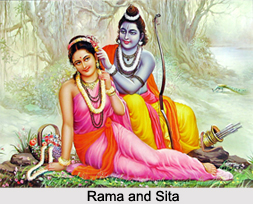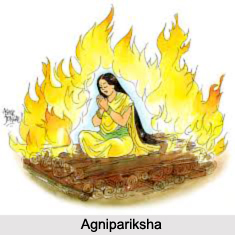 Sita is one of the central characters of Ramayana, the Hindu epic. She is the wife of Lord Rama and is believed to be the paramount of sanctity, courage and self sacrifice. She sprang from a furrow when king Janaka was ploughing his field and Rama won her as his bride by bending the Shiva`s bow. Following her marriage, she was exiled along with her husband and brother-in-law, Lakshmana, for fourteen years. Sita`s abduction by the demon king Ravana during the exile and her subsequent rescue are described in Ramayana. After her return to Ayodhya she proved her chastity by undergoing an ordeal by fire. Later after giving birth to twin sons she reunited to her mother, the Earth`s womb. Being the symbol of the sufferings and strengths of women, she is one of the most revered figures in the Hindu pantheon.
Sita is one of the central characters of Ramayana, the Hindu epic. She is the wife of Lord Rama and is believed to be the paramount of sanctity, courage and self sacrifice. She sprang from a furrow when king Janaka was ploughing his field and Rama won her as his bride by bending the Shiva`s bow. Following her marriage, she was exiled along with her husband and brother-in-law, Lakshmana, for fourteen years. Sita`s abduction by the demon king Ravana during the exile and her subsequent rescue are described in Ramayana. After her return to Ayodhya she proved her chastity by undergoing an ordeal by fire. Later after giving birth to twin sons she reunited to her mother, the Earth`s womb. Being the symbol of the sufferings and strengths of women, she is one of the most revered figures in the Hindu pantheon.
Etymology of Sita
The name Sita has been derived from the Sanskrit word `sita` which refers to furrow. Ramayana says that, she was found by Janaka while ploughing the field and was adopted by him. Some believe that she was named after an ancient Vedic Goddess known as Sita who is an earth goddess and blesses the land with crops as mentioned in Rig Veda. Sita was also known as the goddess of fertility in Vedic era. There are several epithets of Sita. Being the daughter of Janaka, she is also called as Janaki and Maithili for being the princess of Mithila. She is also known as Vaidehi as her father was called as Videha for his ability of transcending body consciousness.
Birth of Sita
Different versions of Ramayana depict Sita`s birth and parentage differently. In Kamban`s Tamil epic Ramavataram and Valmiki`s Ramayana she has been mentioned to have discovered in a furrow by the king of Mithila, Janaka. Ramayana Manjari describes the wishes of Janaka for obtaining a child. On finding the child, he hears a voice from the sky which states that Sita is her spiritual child born of Menaka. Some other versions of Ramayana depict her to be the reincarnation of Vedavati and also of Manivati in some cases. In Sanghadasa`s Jaina version of Ramayana it has been mentioned that Sita was born as Ravana`s daughter who abandons her and orders to have her buried in some distant land and this was how she was found by Janaka.
 Marriage of Sita
Marriage of Sita
Janaka organizes a `Swayamvara` when Sita reaches her adulthood. The king places a condition that whoever would be able to break the bow of Shiva would marry his daughter. The bow was however not liftable for ordinary mortals and not approachable for the selfish ones. During this event, Vishwamitra who had brought Rama and Lakshmana to the forest for the protection of sacrifice advises them to participate in the same. In the Swayamvara, Rama lifts the bow and breaks it as per the condition. Thus he fulfils Janaka`s expectations and marries Sita in a marriage ceremony conducted under the guidance of Satananda.
Exile and Abduction of Sita
Soon after the wedding, Rama had to leave his kingdom Ayodhya due to various circumstances to spend a period of fourteen years in exile. Sita willingly accompanies her husband leaving behind the comforts of a palace and spends days in Dandaka and Panchavati forests. Ravana, the king of Lanka, however abducts her from Panchvati forest by disguising her in the appearance of a Brahmana mendicant. During her abduction Rama was away to fetch a magnificent golden deer for her. The vulture king and the friend of Dasaratha (Rama`s father), Jatayu, tries to protect her but the Ravana chops his wings. He however survives till he informs Rama about the abduction. Sita was imprisoned in one of Ravana`s palaces for a year and during this phase Ravana had many a time expressed his desires for her which she strongly refused and fought back to maintain her chastity. Sita`s whereabouts were rightly traced by Lord Hanuman who was sent by Rama. While searching for Sita, Hanuman was also caught for trespassing in Lanka and as a punishment his tail was set on fire. He somehow managed to escape owing to his superior strength and also burnt down much of Lanka with his tail which was on fire. He thus reached to Rama across the sea along with the jewellery that Sita had asked him to give to her husband. The rescue of Sita followed the famous battle of Ramayana where Ravana was defeated by Rama. 
Agnipariksha of Sita
After being victorious in the war, the couple returned to their kingdom and Rama was coronated as the new king. Although Rama had always trusted his wife`s chastity, the society could not accept it after her captivity in Lanka. For combating the allegations, Rama asked her to prove her chastity by undergoing a test of fire which is known as Agnipariksha. When Sita steps into the sacrificial fire, the lord of fire, Agni, raises Sita to the throne unharmed which attests her purity. However even after the Agnipariksha, rumours continued to spread across the kingdom owing to which Rama reluctantly sends his wife away to spend a second period of exile. During this time, Sita was pregnant and after wandering in the forest took refuge in the hermitage of Valmiki. There she gave birth to twin sons, Luv and Kusha. She raised her children as a single mother in the hermitage and after growing up, her children reunited with their father. Subsequently Sita pleaded her mother, Earth, to free her from this unjust world and bestow the final refuge in Mother Earth`s arms. On her pleas, the earth split opened and took her away to a better world.
Sita in Indian Society
The characterization of Sita has left an everlasting imprint on Indian society. Traditional Indian society conceives Sita as an ideal daughter, wife and mother. At every juncture of her life, her actions are regarded as ideal and through generations and changing lifestyles these have strengthened the traditional values of Indians. However some contemporary views differ in this context and visualize Sita as a helpless woman who needed assistance and support of the male folk. However some of the values she has enshrined in the society since olden days still find their validity in the contemporary world through her certain actions such as her refusal to return with Hanuman as a thief and her demand to Rama for saving her by defeating Ravana. Also the dignity and honour revealed by her character remains undisputed which is demonstrated in several actions among which the most prominent ones are the Agnipariksha and her pleas to Mother Earth for taking her away to despise the life of misery and misapprehensions. Although her character has complex explanations and the values she enshrined on Indian society have been the subject of varied interpretations, Sita always remains one of the most esteemed characters of Indian mythology.












